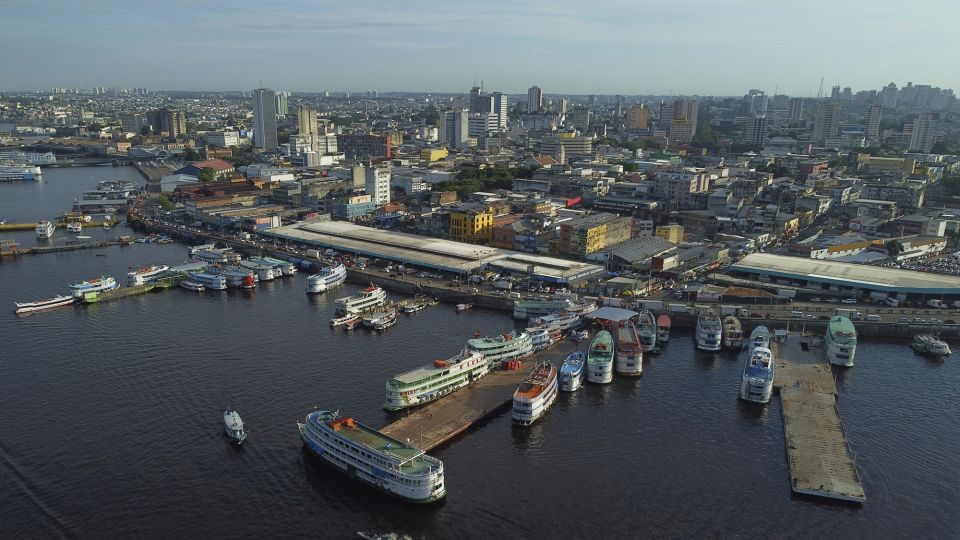Huge tributaries that feed the mighty Amazon River – the largest in the world – have fallen to record levels, upending lives, stranding boats and endangering dolphins as drought grips Brazil.
According to Cemaden, the country’s natural disaster monitoring center, the country is currently experiencing its worst drought since records began in 1950. It is the second year in a row of extreme drought in Brazil. Nearly 60% of the country is affected, while some cities, including the capital Brasilia, survive more than 140 consecutive days without rain.
In the heart of the Amazon rainforest, the impact on rivers is shocking and experts are sounding the alarm about what this means for the region. a hotspot for biodiversity and crucial climate change buffer.
The Rio Negro, one of the Amazon’s largest tributaries, is at a low point for this time of year near the city of Manaus in Amazonas state. The water level is dropping about 7 centimeters per dayThis is reported by the Geological Survey of Brazil.
The river’s characteristic jet-black water usually flows through the thick maze of channels, but satellite images now show it has shrunk drastically and huge swaths of the riverbed are visible.
The Rio Negro is seeing “extreme reductions” as temperatures rise and the region faces a lack of rainfall, said Lincoln Alves, a research scientist at Brazil’s National Institute for Space Research.
This also applies to the Solimões River, whose muddy waters join the Rio Negro near Manaus to form the Amazon River.
This month the Solimões fell to its foundations lowest level ever measured for this time of year in Tabatinga, a Brazilian city on the border with Colombia and Peru.
Ships are stranded and vast expanses of sand are visible where water once flowed.
Lake Tefé, on the northern bank of the Solimões River, is also severely depleted.
Photos of the lake last month show it has shrunk dramatically compared to the same time last year, and is still declining. It contributes to critical water shortages and impacts local ecosystems, Alves says.
Last year there were more than 200 dolphins found dead in the lake during a historic drought and record high water temperatures, and experts fear a repeat this year.
Dolphin deaths are already happening. “Last week we found an average of one per day,” says Miriam Marmontel, head of the dolphin project at the Mamirauá Institute for Sustainable Development. Reuters earlier this month.
Researchers believe that as the lake shrinks, there is less room for dolphins, putting them at greater risk of collisions with boats and ferries.
In many regions of the Amazon, “the drought is already more intense today than it was at its worst last year,” said Romulo Batista, biologist and spokesperson for Greenpeace Brazil.
“The minimum values in these rivers … are usually at the end of October,” says Adriana Cuartas, researcher at Cemaden. They happened earlier this year and water levels will continue to drop, she told CNN.
The consequences are dire for locals who rely on the rivers for food, medicine, livelihoods and transportation, said André Guimarães, executive director of the nonprofit Amazon Environmental Research Institute.
“We are dealing with an unprecedented situation,” he told CNN, adding: “The reduction in river flows is absolutely enormous.”
Brazil’s severe and prolonged drought is caused by a range of factors.
An intense El Niño, a natural climate pattern, brought warmer and drier weather to the region last year and into 2024. El Niño has now passed, but heat and drought are affected by an unusually hot Atlantic Ocean, Cemaden’s Cuartas said.
Deforestation is also a factor, Alves said, helping to raise temperatures and change rainfall patterns. “The continued decline of the ecosystem is pushing the region towards a potential tipping point,” he said.
Then there is climate change, caused by the burning of fossil fuels that warm the planet, leading to warmer temperatures and longer periods without rain.
Last year’s devastating drought in the Amazon basin was caused 30 times more likely by climate change, according to a report from World Weather Attribution, a network of scientists who analyze extreme weather events.
What is happening in Brazil “is a tragic example of a local impact of global climate change,” Guimarães said, referring to the fact that it is often poorer, less developed countries that bear the brunt of the effects of climate change that are disproportionately caused by richer countries.
Earlier this month, environmental group Greenpeace unveiled a large banner reading: “Who pays?” on the newly exposed sandbanks of the Solimões.
The drought has also paved the way for devastating forest fires in Brazil, which have devastated large parts of the Amazon as well as the Pantanalthe world’s largest tropical wetlands, and cities choked in thick smoke.
There is little relief in sight. Rainfall at levels that could recharge rivers is not expected for weeks to come and river levels are expected to continue to fall.
“The situation will continue to deteriorate until November,” Cuartas said.
For more CNN news and newsletters, create an account at CNN.com

